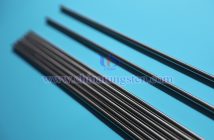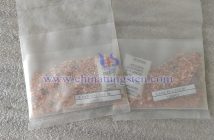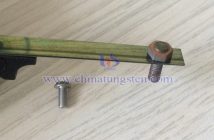In today’s rapidly developing automotive industry, material innovation and application have been key drivers of progress. From traditional steel to the later emergence of aluminum alloys and carbon fiber, each introduction of a new material has brought a qualitative leap in automotive performance. Beyond aluminum alloys and carbon fiber, high-density tungsten alloy is also a critical material in the automotive sector. While it may still seem unfamiliar to the general public, in the eyes of engineers, tungsten alloy is becoming a "secret weapon" for solving specific technical challenges, thanks to its exceptional properties.
High-density tungsten alloy is primarily composed of tungsten (with a content of 85%–99%) and incorporates small amounts of elements such as nickel (Ni), copper (Cu), cobalt (Co), molybdenum (Mo), and chromium (Cr). It boasts high density, high strength, excellent radiation absorption, high thermal conductivity, low thermal expansion coefficient, good electrical conductivity, and outstanding weldability and machinability. It is widely used in fields such as aerospace, aviation, oil drilling, electrical instrumentation, and medical applications. So, what kind of sparks fly when this versatile material meets the automotive industry?

1. What is High-Density Tungsten Alloy?
High-density tungsten alloy is a material primarily based on tungsten (content 85%–99%), with a standout characteristic of its high density, ranging from 16.5–18.75 g/cm3, making it highly advantageous in applications requiring high-density materials. In terms of manufacturing, traditional powder metallurgy techniques are well-established, while emerging additive manufacturing technologies have opened up broader application prospects.
Depending on the composition, tungsten-based alloys can be categorized into series such as tungsten-nickel-iron (W-Ni-Fe) and tungsten-nickel-copper (W-Ni-Cu). Tungsten-nickel-iron alloys are characterized by high density, high strength, good electrical and thermal conductivity, strong absorption of γ-rays or X-rays, and some ferromagnetic properties, making them suitable for various counterweights, balance weights, and radiation shielding components. Tungsten-nickel-copper alloys, being non-magnetic, are ideal for precision instruments sensitive to electromagnetic environments.
Initially used in military applications, such as armor-piercing projectile cores and rocket nozzles, high-density tungsten alloy has gradually entered civilian sectors with technological advancements, playing a significant role in automotive counterweights and medical radiation shielding. Compared to traditional lead materials, tungsten alloy offers higher density and superior overall performance.

2. Why Tungsten Alloy Makes It into Cars: Unveiling Its Advantages
High-density tungsten alloy’s rise in the automotive sector is not by chance but due to its array of exceptional properties that align with the stringent material requirements of the automotive industry.

2.1 Exceptional Counterweight Capability
In automotive design and manufacturing, counterweights are critical. The appropriateness of counterweights affects vehicle handling stability, driving safety, and comfort. With a density of 16.5–18.75 g/cm3, high-density tungsten alloy has a clear advantage in counterweight applications. Compared to other counterweight materials like lead or iron, tungsten alloy requires less volume for the same weight. This is a significant benefit in scenarios where internal vehicle space is limited, enabling more efficient weight distribution within confined spaces.
For example, in race cars, which demand high handling performance at high speeds, optimizing weight distribution is crucial. The use of high-density tungsten alloy counterweights allows for ideal weight allocation without occupying excessive space, enabling race cars to maintain stable posture during high-speed cornering, acceleration, and braking, thereby enhancing handling and competitive performance.

2.2 Outstanding Mechanical Properties
During vehicle operation, components are subjected to forces from various directions, including tension, compression, bending, and impact. This requires automotive materials to have excellent mechanical properties to ensure components function properly under complex stress conditions without failing due to fracture or deformation. High-density tungsten alloy boasts high tensile strength, good crack resistance, and ductility, making it suitable for manufacturing automotive engine crankshafts.
The crankshaft, a critical engine component, endures periodically varying gas pressure, reciprocating inertial forces, centrifugal forces, and the resulting torques and bending moments during engine operation. With its superior mechanical properties, high-density tungsten alloy can withstand these complex stresses, ensuring the crankshaft maintains reliable performance during prolonged high-speed rotation, reducing wear and the risk of fatigue fracture, thus enhancing the engine’s reliability and lifespan.

2.3 Stable Chemical Properties
Vehicles are inevitably exposed to complex environments during use, such as humid air, rainwater, and acidic or alkaline substances. This places high demands on the chemical stability of automotive components, with corrosion-resistant and oxidation-resistant materials extending component lifespan and reducing maintenance costs. High-density tungsten alloy exhibits stable chemical properties, demonstrating excellent corrosion and oxidation resistance in common environmental media.
Automotive components made from high-density tungsten alloy, such as certain chassis counterweights or engine parts, can resist corrosion from seawater mist and salt. Throughout a vehicle’s lifecycle, tungsten alloy components require less frequent replacement, reducing user costs and improving overall vehicle reliability and stability.
2.4 Environmentally Friendly and Non-Toxic
With growing environmental awareness, the automotive industry’s demand for eco-friendly materials is increasing. Lead, once a common counterweight material, is a heavy metal that poses risks to human health and the environment.
In contrast, high-density tungsten alloy is environmentally friendly, non-toxic, and non-radioactive. Using tungsten alloy instead of lead in automotive production aligns with the industry’s sustainable development principles.



